Abstract
OBJECTIVE: To document long-term results associated with an coordinated plan of care for acutely burned hands in children. SUMMARY AND BACKGROUND DATA: Optimal hand function is a crucial component of a high-quality survival after burn injury. This can be achieved only with a coordinated approach to the injuries. Long-term outcomes associated with such a plan of care have not been previously reported. METHODS: Over a 10-year period, 495 children with 698 acutely burned hands were managed at a regional pediatric burn facility; 219 children with 395 injured hands were followed in the authors' outpatient clinic for at least 1 year and an average of >5 years. The authors' approach to the acutely burned hand emphasizes ranging and splinting throughout the hospital stay, prompt sheet autograft wound closure as soon as practical, and the selective use of axial pin fixation and flaps. Long-term follow-up, hand therapy, and reconstructive surgery are emphasized. RESULTS: Normal functional results were seen in 97% of second-degree and 85% of third-degree injuries; in children with burns involving underlying tendon and bone, 70% could perform activities of daily living and 20% had normal function. Reconstructive hand surgery was required in 4.4% of second-degree burns, 32% of third-degree burns, and 65% of those with injuries involving underlying bone and tendon. CONCLUSIONS: When managed in a coordinated long-term program, the large majority of children with serious hand burns can be expected to have excellent functional results.
Full text
PDF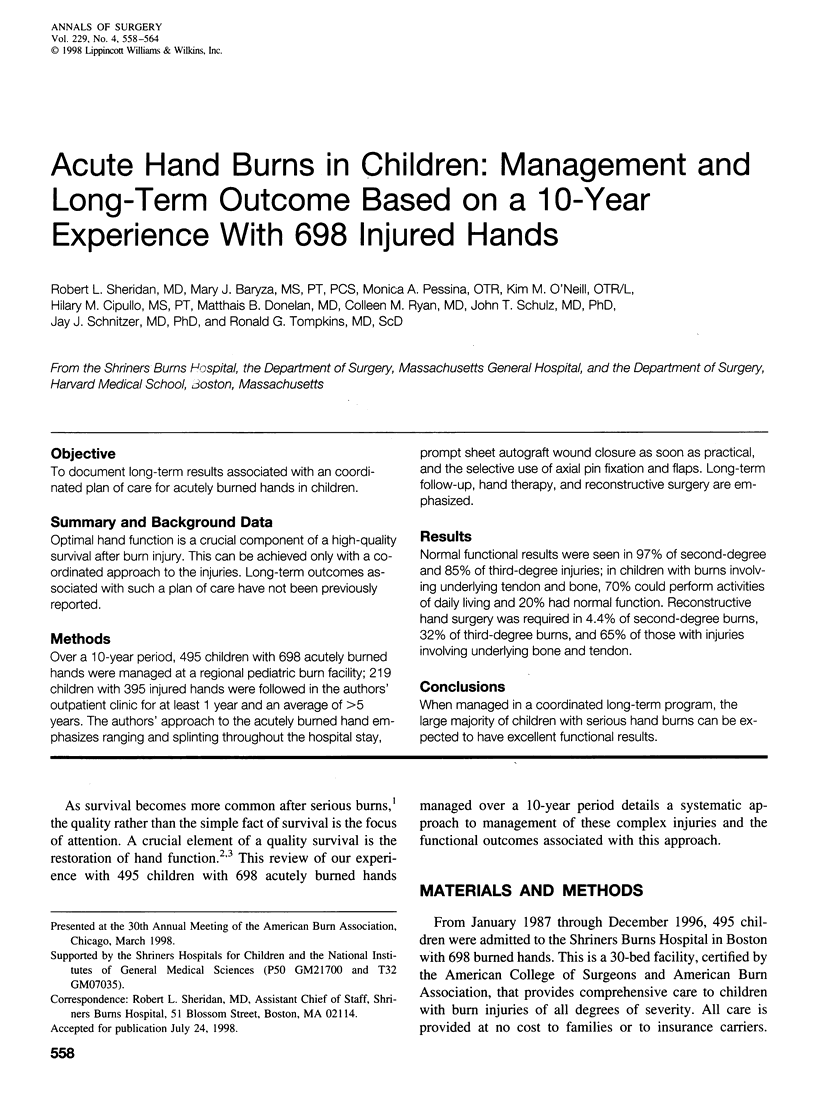
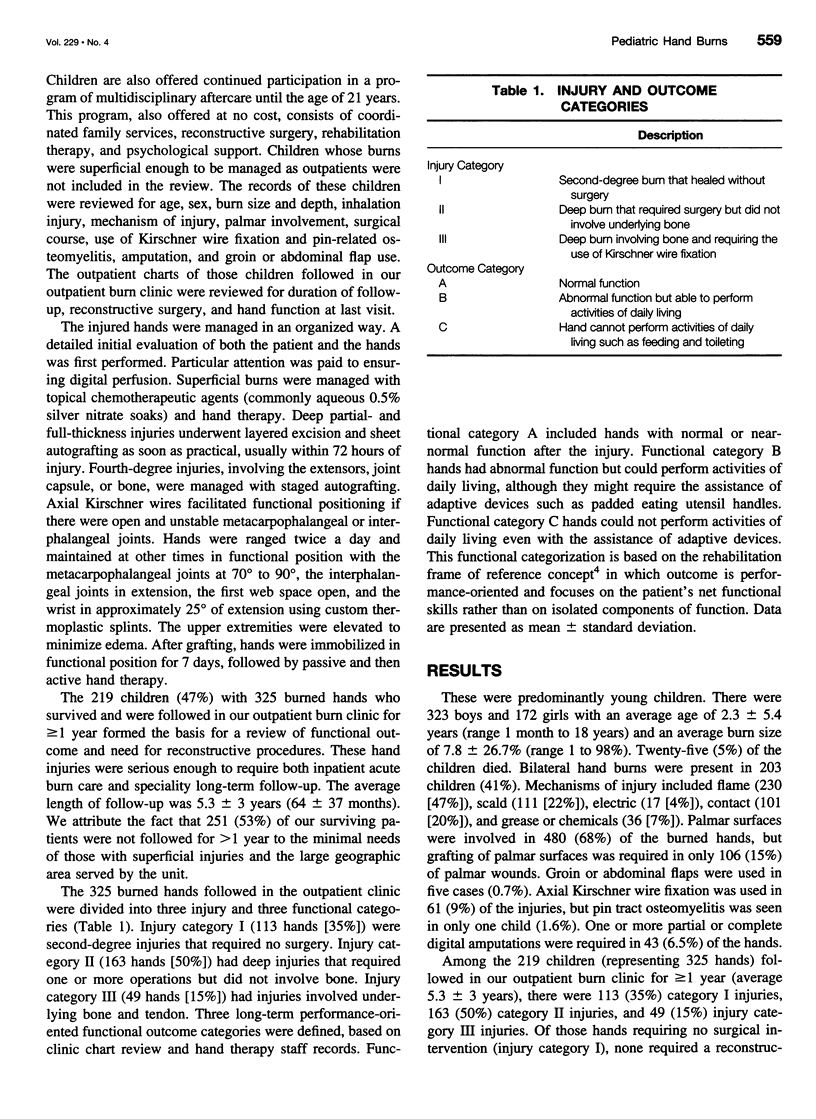
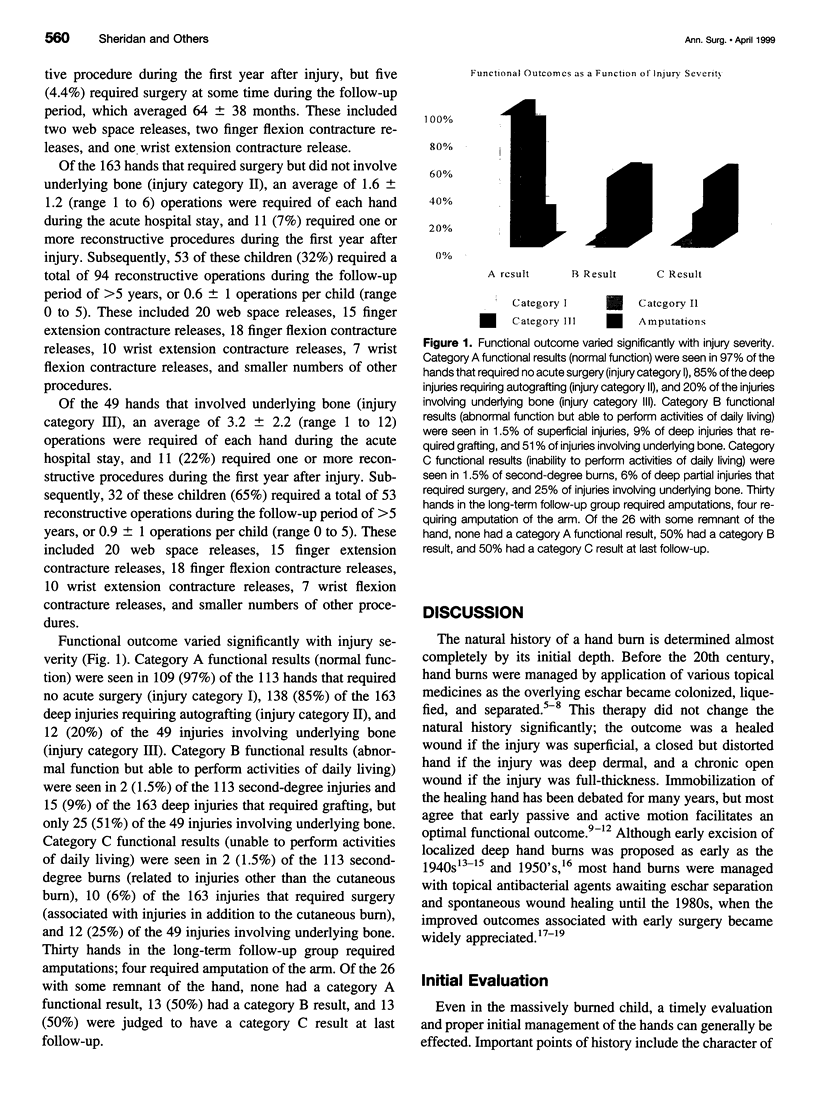
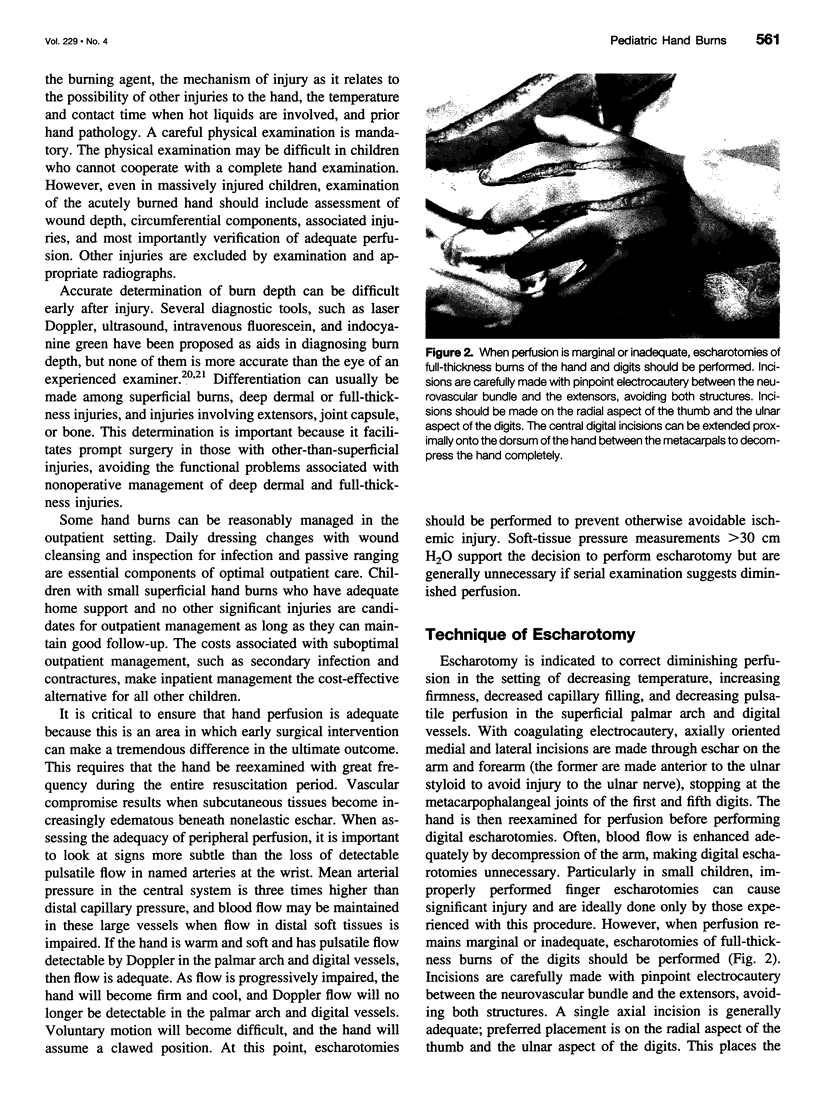
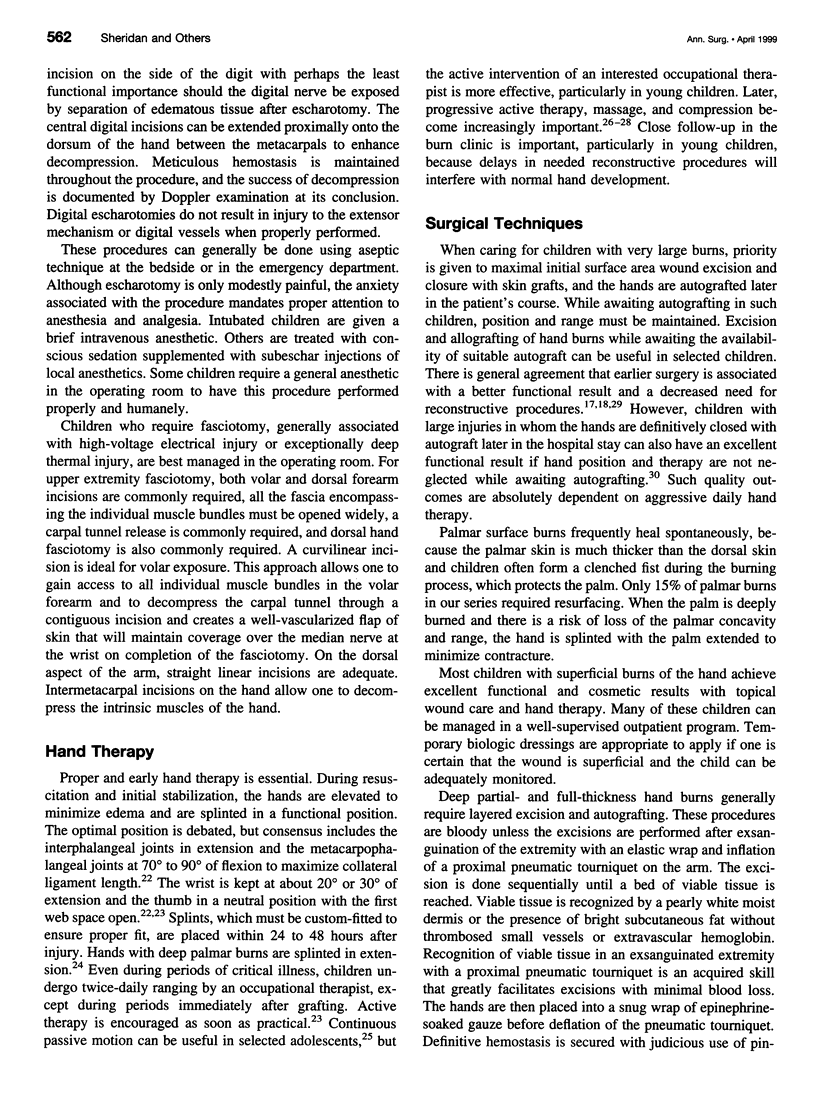
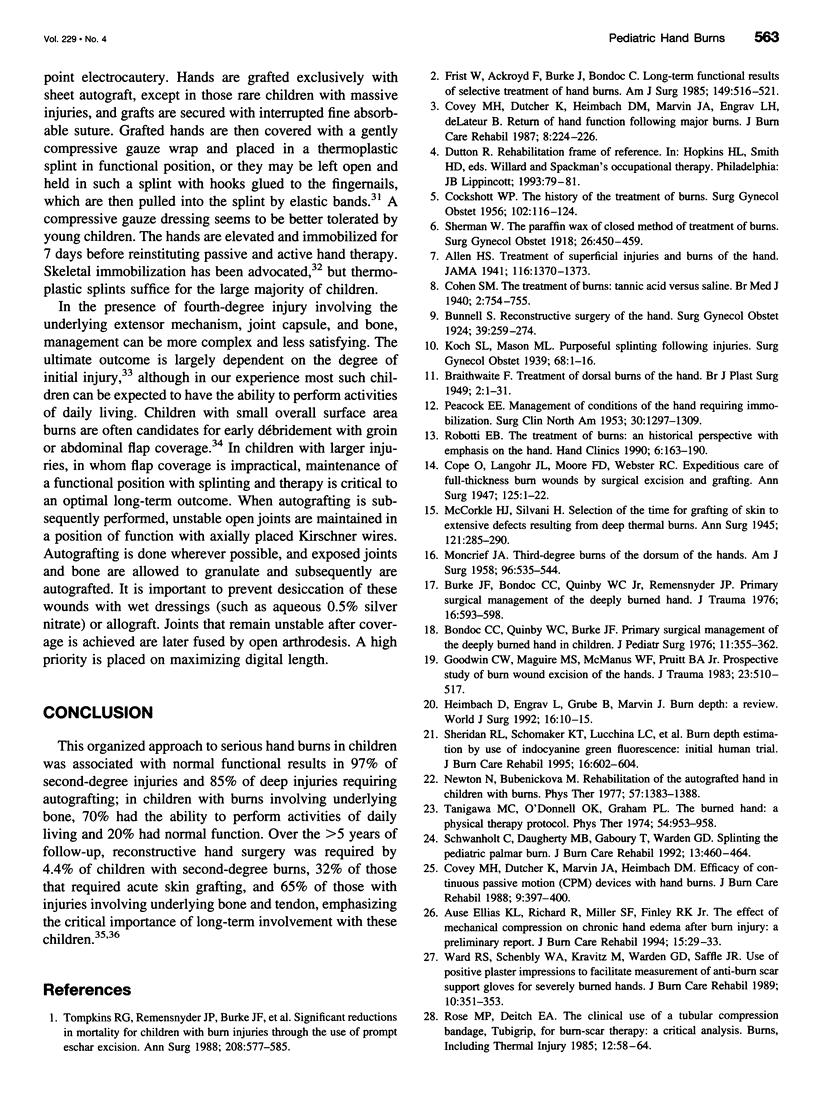

Images in this article
Selected References
These references are in PubMed. This may not be the complete list of references from this article.
- Ause-Ellias K. L., Richard R., Miller S. F., Finley R. K., Jr The effect of mechanical compression on chronic hand edema after burn injury: a preliminary report. J Burn Care Rehabil. 1994 Jan-Feb;15(1):29–33. doi: 10.1097/00004630-199401000-00006. [DOI] [PubMed] [Google Scholar]
- Bondoc C. C., Quinby W. C., Burke J. F. Primary surgical management of the deeply burned hand in children. J Pediatr Surg. 1976 Jun;11(3):355–362. doi: 10.1016/s0022-3468(76)80189-3. [DOI] [PubMed] [Google Scholar]
- Broelsch C. E., Whitington P. F., Emond J. C., Heffron T. G., Thistlethwaite J. R., Stevens L., Piper J., Whitington S. H., Lichtor J. L. Liver transplantation in children from living related donors. Surgical techniques and results. Ann Surg. 1991 Oct;214(4):428–439. doi: 10.1097/00000658-199110000-00007. [DOI] [PMC free article] [PubMed] [Google Scholar]
- Burke J. F., Bondoc C. C., Quinby W. C., Jr, Remensnyder J. P. Primary surgical management of the deeply burned hand. J Trauma. 1976 Aug;16(08):593–598. doi: 10.1097/00005373-197608000-00001. [DOI] [PubMed] [Google Scholar]
- COCKSHOTT W. P. The book shelf; the history of the treatment of burns. Surg Gynecol Obstet. 1956 Jan;102(1):116–124. [PubMed] [Google Scholar]
- Cope O., Langohr J. L., Moore F. D., Webster R. C. Expeditious Care of Full-Thickness Burn Wounds by Surgical Excision and Grafting. Ann Surg. 1947 Jan;125(1):1–22. [PMC free article] [PubMed] [Google Scholar]
- Covey M. H., Dutcher K., Heimbach D. M., Marvin J. A., Engrav L. H., deLateur B. Return of hand function following major burns. J Burn Care Rehabil. 1987 May-Jun;8(3):224–226. doi: 10.1097/00004630-198705000-00011. [DOI] [PubMed] [Google Scholar]
- Covey M. H., Dutcher K., Marvin J. A., Heimbach D. M. Efficacy of continuous passive motion (CPM) devices with hand burns. J Burn Care Rehabil. 1988 Jul-Aug;9(4):397–400. [PubMed] [Google Scholar]
- Earle A. S., Fratianne R. B. Delayed definitive reconstruction of the burned hand: evolution of a program of care. J Trauma. 1979 Mar;19(3):149–152. doi: 10.1097/00005373-197903000-00003. [DOI] [PubMed] [Google Scholar]
- Frist W., Ackroyd F., Burke J., Bondoc C. Long-term functional results of selective treatment of hand burns. Am J Surg. 1985 Apr;149(4):516–521. doi: 10.1016/s0002-9610(85)80049-0. [DOI] [PubMed] [Google Scholar]
- Frist W., Ackroyd F., Burke J., Bondoc C. Long-term functional results of selective treatment of hand burns. Am J Surg. 1985 Apr;149(4):516–521. doi: 10.1016/s0002-9610(85)80049-0. [DOI] [PubMed] [Google Scholar]
- Goodwin C. W., Maguire M. S., McManus W. F., Pruitt B. A., Jr Prospective study of burn wound excision of the hands. J Trauma. 1983 Jun;23(6):510–517. doi: 10.1097/00005373-198306000-00012. [DOI] [PubMed] [Google Scholar]
- Hanumadass M., Kagan R., Matsuda T. Early coverage of deep hand burns with groin flaps. J Trauma. 1987 Feb;27(2):109–114. doi: 10.1097/00005373-198702000-00001. [DOI] [PubMed] [Google Scholar]
- Harnar T., Engrav L., Heimbach D., Marvin J. A. Experience with skeletal immobilization after excision and grafting of severely burned hands. J Trauma. 1985 Apr;25(4):299–302. doi: 10.1097/00005373-198504000-00003. [DOI] [PubMed] [Google Scholar]
- Heimbach D., Engrav L., Grube B., Marvin J. Burn depth: a review. World J Surg. 1992 Jan-Feb;16(1):10–15. doi: 10.1007/BF02067108. [DOI] [PubMed] [Google Scholar]
- Levine B. A., Sirinek K. R., Peterson H. D., Pruitt B. A., Jr Efficacy of tangential excision and immediate autografting of deep second-degree burns of the hand. J Trauma. 1979 Sep;19(9):670–673. doi: 10.1097/00005373-197909000-00006. [DOI] [PubMed] [Google Scholar]
- MONCRIEF J. A. Third degree burns of the dorsum of the hand. Am J Surg. 1958 Oct;96(4):535–544. doi: 10.1016/0002-9610(58)90971-1. [DOI] [PubMed] [Google Scholar]
- McCorkle H. J., Silvani H. Selection of the Time for Grafting of Skin to Extensive Defects Resulting from Deep Thermal Burns. Ann Surg. 1945 Mar;121(3):285–290. doi: 10.1097/00000658-194503000-00003. [DOI] [PMC free article] [PubMed] [Google Scholar]
- Newton N., Bubenickova M. Rehabilitation of the autografted hand in children with burns. Phys Ther. 1977 Dec;57(12):1383–1388. doi: 10.1093/ptj/57.12.1383. [DOI] [PubMed] [Google Scholar]
- PEACOCK E. E. Management of conditions of the hand requiring immobilization. Surg Clin North Am. 1953 Oct;:1297–1309. doi: 10.1016/s0039-6109(16)34035-x. [DOI] [PubMed] [Google Scholar]
- Robotti E. B. The treatment of burns: an historical perspective with emphasis on the hand. Hand Clin. 1990 May;6(2):163–190. [PubMed] [Google Scholar]
- Rose M. P., Deitch E. A. The clinical use of a tubular compression bandage, Tubigrip, for burn-scar therapy: a critical analysis. Burns Incl Therm Inj. 1985 Oct;12(1):58–64. doi: 10.1016/0305-4179(85)90184-6. [DOI] [PubMed] [Google Scholar]
- Schwanholt C., Daugherty M. B., Gaboury T., Warden G. D. Splinting the pediatric Palmar burn. J Burn Care Rehabil. 1992 Jul-Aug;13(4):460–464. doi: 10.1097/00004630-199207000-00014. [DOI] [PubMed] [Google Scholar]
- Sheridan R. L., Hurley J., Smith M. A., Ryan C. M., Bondoc C. C., Quinby W. C., Jr, Tompkins R. G., Burke J. F. The acutely burned hand: management and outcome based on a ten-year experience with 1047 acute hand burns. J Trauma. 1995 Mar;38(3):406–411. doi: 10.1097/00005373-199503000-00022. [DOI] [PubMed] [Google Scholar]
- Sheridan R. L., Schomaker K. T., Lucchina L. C., Hurley J., Yin L. M., Tompkins R. G., Jerath M., Torri A., Greaves K. W., Bua D. P. Burn depth estimation by use of indocyanine green fluorescence: initial human trial. J Burn Care Rehabil. 1995 Nov-Dec;16(6):602–604. doi: 10.1097/00004630-199511000-00007. [DOI] [PubMed] [Google Scholar]
- Tanigawa M. C., O'Donnell O. K., Graham P. L. The burned hand: a physical therapy protocol. Phys Ther. 1974 Sep;54(9):953–958. doi: 10.1093/ptj/54.9.953. [DOI] [PubMed] [Google Scholar]
- Tompkins R. G., Remensnyder J. P., Burke J. F., Tompkins D. M., Hilton J. F., Schoenfeld D. A., Behringer G. E., Bondoc C. C., Briggs S. E., Quinby W. C., Jr Significant reductions in mortality for children with burn injuries through the use of prompt eschar excision. Ann Surg. 1988 Nov;208(5):577–585. doi: 10.1097/00000658-198811000-00006. [DOI] [PMC free article] [PubMed] [Google Scholar]
- Von Prince K. M., Curreri P. W., Pruitt B. A., Jr Application of fingernail hooks in splinting of burned hands. Am J Occup Ther. 1970 Nov-Dec;24(8):556–559. [PubMed] [Google Scholar]
- Ward R. S., Schenbly W. A., Kravitz M., Warden G. D., Saffle J. R. Use of positive plaster impressions to facilitate measurement of anti-burn scar support gloves for severely burned hands. J Burn Care Rehabil. 1989 Jul-Aug;10(4):351–353. doi: 10.1097/00004630-198907000-00012. [DOI] [PubMed] [Google Scholar]




